外研版七年级下册英语课件 Module 11 Body language Unit 3 Language in use课件(共48张PPT)
文档属性
| 名称 | 外研版七年级下册英语课件 Module 11 Body language Unit 3 Language in use课件(共48张PPT) | 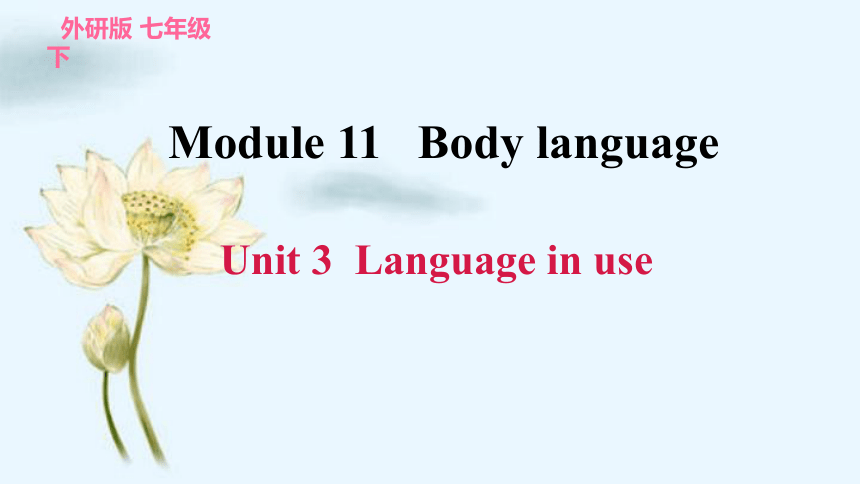 | |
| 格式 | zip | ||
| 文件大小 | 785.5KB | ||
| 资源类型 | 教案 | ||
| 版本资源 | 外研版 | ||
| 科目 | 英语 | ||
| 更新时间 | 2021-05-17 09:04:21 | ||
图片预览



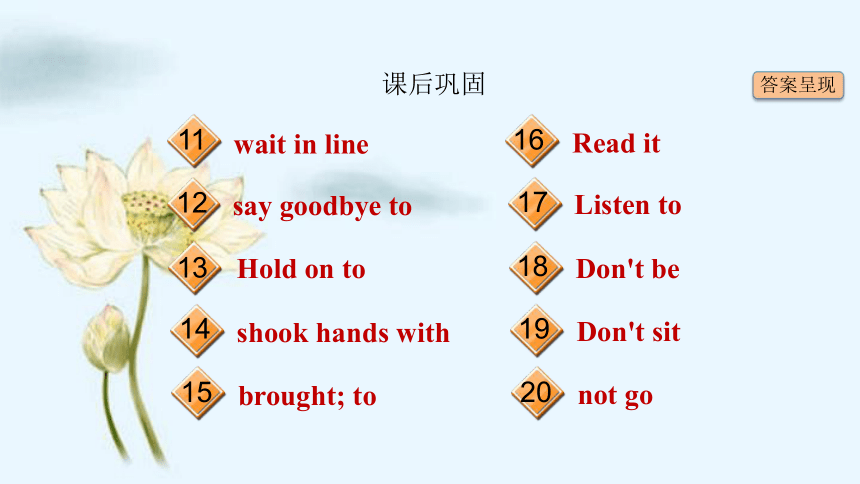
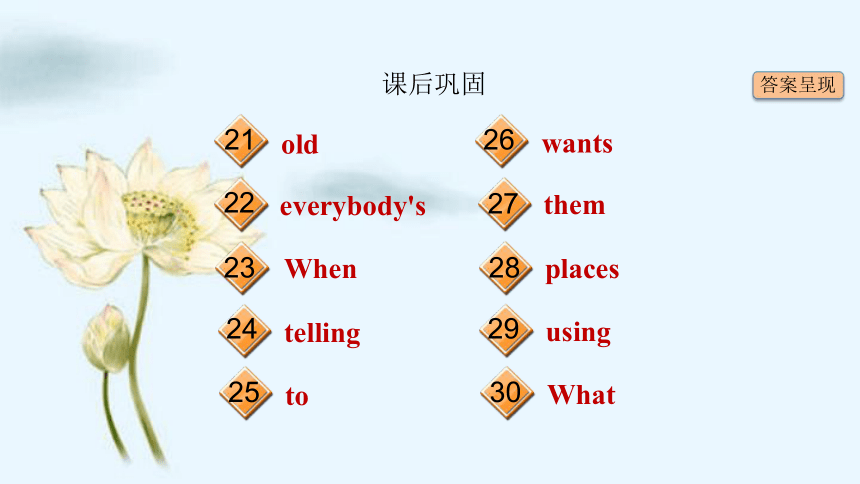
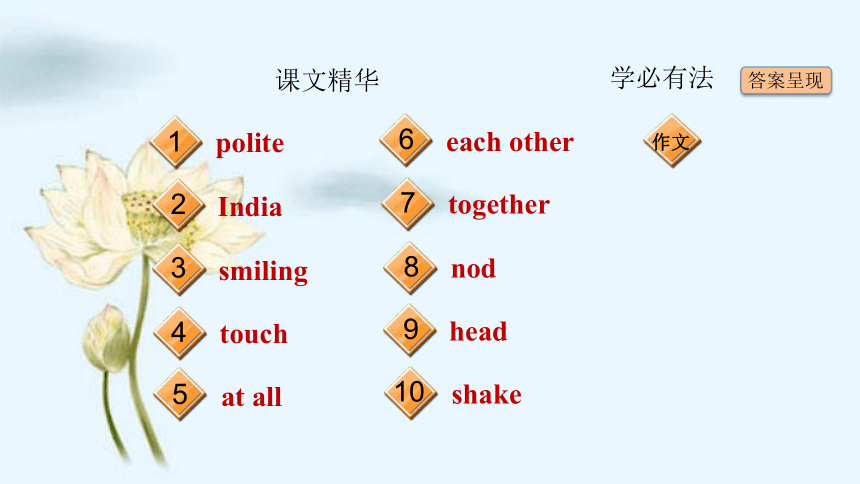
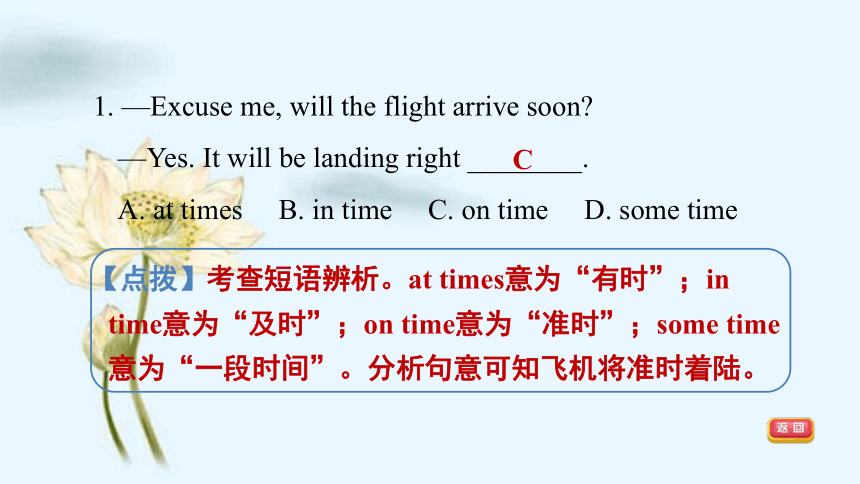
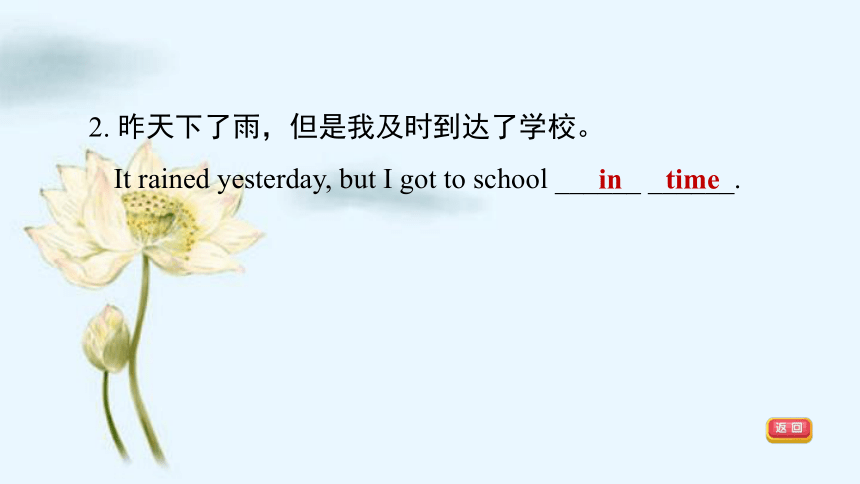
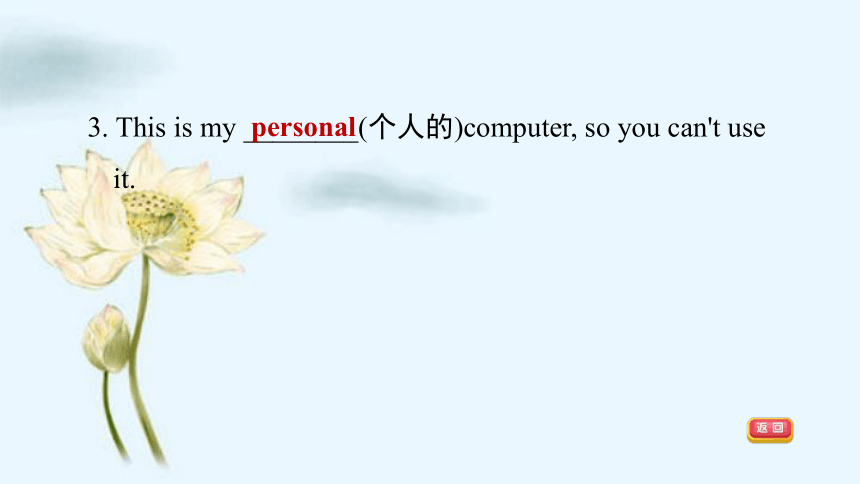
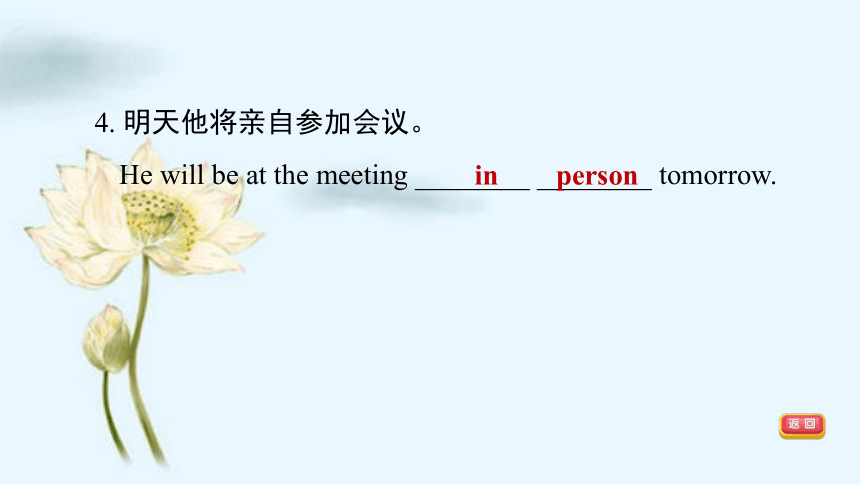
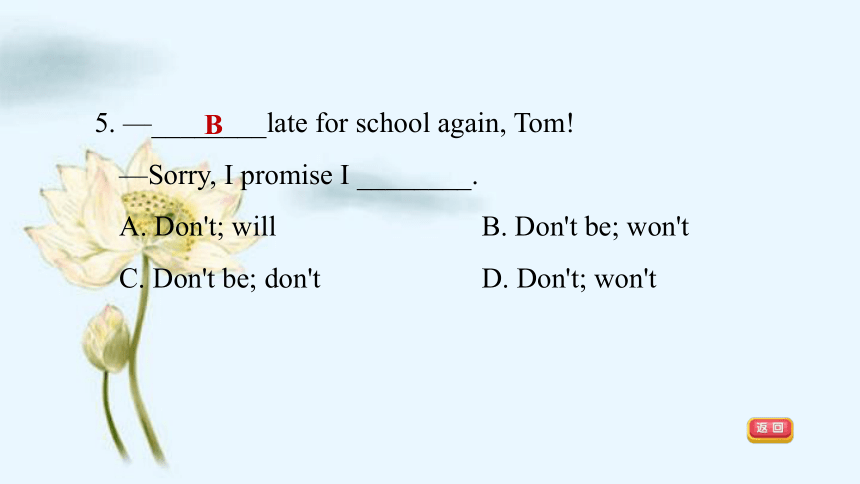
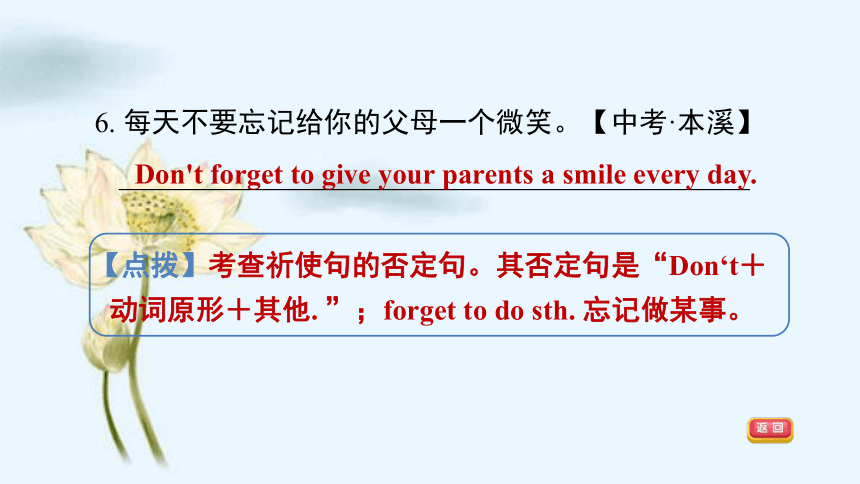
文档简介
(共48张PPT)
Unit
3
Language
in
use
外研版
七年级下
Module
11
Body
language
题组专训
提示:点击
进入习题
答案呈现
1
2
C
in
time
3
4
personal
in
person
5
B
6
7
Don't
forget
to
give
your
parents
a
smile
every
day.
C
8
B
答案呈现
课后巩固
1
2
3
4
5
6
7
8
9
10
B
A
C
B
C
are
Don't
walk
Japanese
visitors
personal
课后巩固
答案呈现
16
17
18
19
20
11
12
13
14
15
wait
in
line
say
goodbye
to
Hold
on
to
shook
hands
with
brought;
to
Read
it
Listen
to
Don't
be
Don't
sit
not
go
课后巩固
答案呈现
26
27
28
29
30
21
22
23
24
25
old
everybody's
When
telling
to
wants
them
places
using
What
答案呈现
1
2
3
4
5
6
7
8
9
10
课文精华
polite
India
smiling
touch
at
all
each
other
together
nod
head
shake
学必有法
作文
1.
—Excuse
me,
will
the
flight
arrive
soon?
—Yes.
It
will
be
landing
right
________.
A.
at
times
B.
in
time
C.
on
time
D.
some
time
C
【点拨】考查短语辨析。at
times意为“有时”;in
time意为“及时”;on
time意为“准时”;some
time意为“一段时间”。分析句意可知飞机将准时着陆。
2.
昨天下了雨,但是我及时到达了学校。
It
rained
yesterday,
but
I
got
to
school
______
______.
in
time
3.
This
is
my
________(个人的)computer,
so
you
can't
use
it.
personal
4.
明天他将亲自参加会议。
He
will
be
at
the
meeting
________
________
tomorrow.
in
person
5.
—________late
for
school
again,
Tom!
—Sorry,
I
promise
I
________.
A.
Don't;
will
B.
Don't
be;
won't
C.
Don't
be;
don't
D.
Don't;
won't
B
6.
每天不要忘记给你的父母一个微笑。【中考·本溪】
____________________________________________
Don't
forget
to
give
your
parents
a
smile
every
day.
【点拨】考查祈使句的否定句。其否定句是“Don‘t+动词原形+其他.
”;forget
to
do
sth.
忘记做某事。
7.
—Don't
forget
________
your
homework
here
tomorrow.
—OK,
we
will.
A.
bring
B.
take C.
to
bring
D.
to
take
C
【点拨】考查动词辨析。
bring意为“把……带来”,指把某物从别处带到说话处;take指把某物从说话处带到别处。分析题目可知指的是把作业带来,故用bring。
8.
When
you
go
out
on
rainy
days,
please
________
an
umbrella
with
you.
A.
bring
B.
take
C.
fetch
D.
get
B
一、单项选择
1.
______when
you
cross
the
road.
A.
To
care
B.
Be
careful
C.
To
be
careful
D.
Be
care
B
2.
Tom
and
Tim
are
twins,
but
they
look
________.
A.
different
B.
same
C.
like
D.
difference
A
3.
________sleep
too
late.
It's
bad
for
your
health.
A.
Can't
B.
Not
to
C.
Don't
D.
Doesn't
C
4.
It's
a
fine
day
today.
How
about
________
a
picnic?
A.
have
B.
having
C.
to
have
D.
had
B
5.
Because
of
the
heavy
rain,
the
plane
didn't
arrive
_____.
A.
at
times
B.
in
time
C.
on
time
D.
some
time
C
【点拨】考查短语辨析。at
times意为“有时”;in
time意为“及时”;on
time意为“准时”;some
time意为“一段时间”。分析句意可知飞机未能按时到达,用on
time。
二、用所给词的适当形式填空
6.
Here
________(be)
some
ways
to
welcome
foreign
actors.
are
【点拨】考查here引导的倒装句。由some
ways可知谓语动词用are。
7.
____________(not
walk)in
the
forest.
It's
dangerous.
Don't
walk
【点拨】考查祈使句。祈使句变否定句时在句首加don't。
8.
Lots
of
_________(Japan)come
to
visit
China
every
year.
Japanese
【点拨】Japanese意思是“日本人”,复数为原形。
9.
Many
________(visit)
come
to
the
Great
Wall
every
day.
visitors
10.
This
is
my
________
(person)
room.
You'd
better
not
come
in.
personal
三、根据汉语提示完成句子
11.
当我们等公交车时要排队等候。
We
must
________
________
________
when
we
wait
for
the
bus.
wait
in
line
12.
我是来向你们道别的。
I
came
here
to
________
________
________
you.
say
goodbye
to
13.
坚持你的梦想,有一天它会实现。
________
________
________
your
dream,
it
will
come
true
one
day.
Hold
on
to
【点拨】hold
on
to意思为“坚持”。
14.
见面时他和我握了手。
He
________
________
________
me
when
he
met
me.
shook
hands
with
【点拨】shake
hands
with意思为“和……握手”。shake的过去式为shook。
15.
六月一号那天我们给孩子们带来了许多礼物。
We
________
many
presents
________
children
on
June
1st.
brought
to
【点拨】考查bring的用法。bring…to…意为“给……带来……”。分析句意可知用一般过去时。
四、语法专练
16.
Will
you
please
read
it
again
more
slowly?(改为祈使句)
________
________
again
more
slowly,
please.
Read
it
17.
If
you
don't
listen
to
me,
I'll
go.
(改为同义句)
________
________
me,
or
I'll
go.
Listen
to
18.
The
teachers
often
tell
the
students
not
to
be
careless.
(改为祈使句)
________
________
careless,
please.
Don't
be
19.
Please
sit
next
to
Nancy.
(改为否定句)
________
________
next
to
Nancy.
Don't
sit
20.
Let's
go
to
school
together.
(改为否定句)
Let's
________
________
to
school
together.
not
go
【点拨】以let's开头的句子也是一种祈使句,其否定句在let's后加not。
五、语法填空
在空格处填入一个适当的词或使用括号中所给词的正确形式填空(每空不多于2个单词)。
There's
one
language
that
people
use
in
every
country.
People,
young
and
________21,
short
and
tall,
use
it
very
often.
It's
____________22(everybody)second
language—sign
(手势)language.
old
everybody's
【点拨】分析句意可知表示所有关系,故用名词所有格。
________23
you
wave
your
hand
in
the
street,
you
are
saying
“hello”
to
your
friend.
When
you
put
up
your
hand
in
class,
you
are
________24(tell)the
teacher
that
you
know
the
answer
________25
the
question.
When
a
policeman
________26(want)
to
stop
cars
or
buses
in
the
street,
he
raises
his
hand.
All
of
________27(they)
are
using
sign
language.
When
telling
to
wants
them
【点拨】when意为“当……时候”
,引导时间状语从句。
【点拨】由句中的are可知是现在进行时,故tell加?-ing。
【点拨】the
answer
to…意为“……的答案”。
In
some
________28(place),
you
have
to
use
sign
language
to
talk
with
others.
For
example,
when
you
are
swimming
with
your
friends,
you
can
have
a
talk
under
water
by
________29
(use)
sign
language.
________30
an
interesting
language!Don't
you
think
so?
places
using
What
【点拨】by为介词,后接动词的-?ing形式。
【点拨】考查感叹句。what引导感叹句时后接名词,名词前常加a/
an或形容词。由句中的an
interesting
language可知用What。
根据所给汉语提示完成单词或短语
Mikisu
is
a
______1
(有礼貌的)
cat.
She's
from
______2
(印度).
She
likes
________3
(微笑),
but
she
doesn't
like
others
to
________4
(触碰)
her
nose
________5
(一点也不).
She
has
a
son
and
a
daughter,
Kisu
and
Misu.
They
love
________6
(彼此)
and
always
play
________7
(一起).
Mikisu
doesn't
want
her
children
to
be
rude.
polite
India
smiling
touch
at
all
each
other
together
Mikisu
says
to
them,
“Now,
we
are
in
India.
As
the
saying
goes,
‘When
in
Rome,
do
as
the
Romans
do.
From
now
on,
________8
(点头)
your
________
9
(头)
when
you
want
to
say
no
and
________10
(摇晃)
your
head
when
you
want
to
say
yes.
”
It's
not
easy
for
Kisu
and
Misu.
Do
you
think
they
will
like
living
in
India?
nod
head
shake
一、话题分析
本模块主题是“肢体语言”,通过学习,我们了解了中外文化在交流中的不同之处,也进一步学会了如何使用肢体语言。
二、写作方法
“两步三注意法”写肢体语言类作文
两步:
1.
简明扼要地提出要说明的话题。
2.
详细阐述话题,可从多个方面、多个角度展开叙述。
三注意:
1.
要思路清晰,逻辑关系合理。
2.
要知识运用准确,时态正确。
3.
要语言生动,简单明了。
三、素材积累
1.
介绍肢体语言类作文的常用词汇:
nod,
smile,
shake
hands,
meet,
kiss,
wave,
point
at,
close,
different,polite,
rude等。
三、素材积累
2.
介绍肢体语言类作文的常用句型:
(1)…is
my
good
friend.
(2)When
they
meet,…
(3)It's
polite
to…
(4)How
about…?
四、写作任务
假设你的班里有一些来自英国的交换生,他们对下面这些肢体语言不太了解。请你根据对这些肢体语言的理解向他们介绍这些肢体语言的含义:1.
点头和摇头;
2.
握手和拥抱;3.
把食指(forefinger)放在嘴前。
要求:1.
行文流畅,表述清楚;2.
不少于80词,包含以上所有内容。
提示短语:shake
hands,
for
the
first
time
五、写作模板
___________________________________________________
___________________________________________________
___________________________________________________
___________________________________________________
___________________________________________________
___________________________________________________
六、满分作文
Welcome
to
China.
Now
I
will
tell
you
some
body
language.
There
is
a
lot
of
body
language
in
China.
We
nod
our
heads
to
say
“Yes”
or
“I
agree”.
We
shake
our
heads
to
say
“No”
or
“I
disagree”.
We
put
the
forefinger
in
front
of
our
mouth
to
say
“Please
be
quiet.”
How
about
shaking
hands?
We
usually
shake
hands
when
we
meet
___________________________________________________
___________________________________________________
___________________________________________________
___________________________________________________
___________________________________________________
___________________________________________________
others
for
the
first
time.
It's
polite
to
hug
our
friends
when
we
haven't
seen
them
for
a
long
time.
I
hope
you
will
use
some
body
language
here.
Unit
3
Language
in
use
外研版
七年级下
Module
11
Body
language
题组专训
提示:点击
进入习题
答案呈现
1
2
C
in
time
3
4
personal
in
person
5
B
6
7
Don't
forget
to
give
your
parents
a
smile
every
day.
C
8
B
答案呈现
课后巩固
1
2
3
4
5
6
7
8
9
10
B
A
C
B
C
are
Don't
walk
Japanese
visitors
personal
课后巩固
答案呈现
16
17
18
19
20
11
12
13
14
15
wait
in
line
say
goodbye
to
Hold
on
to
shook
hands
with
brought;
to
Read
it
Listen
to
Don't
be
Don't
sit
not
go
课后巩固
答案呈现
26
27
28
29
30
21
22
23
24
25
old
everybody's
When
telling
to
wants
them
places
using
What
答案呈现
1
2
3
4
5
6
7
8
9
10
课文精华
polite
India
smiling
touch
at
all
each
other
together
nod
head
shake
学必有法
作文
1.
—Excuse
me,
will
the
flight
arrive
soon?
—Yes.
It
will
be
landing
right
________.
A.
at
times
B.
in
time
C.
on
time
D.
some
time
C
【点拨】考查短语辨析。at
times意为“有时”;in
time意为“及时”;on
time意为“准时”;some
time意为“一段时间”。分析句意可知飞机将准时着陆。
2.
昨天下了雨,但是我及时到达了学校。
It
rained
yesterday,
but
I
got
to
school
______
______.
in
time
3.
This
is
my
________(个人的)computer,
so
you
can't
use
it.
personal
4.
明天他将亲自参加会议。
He
will
be
at
the
meeting
________
________
tomorrow.
in
person
5.
—________late
for
school
again,
Tom!
—Sorry,
I
promise
I
________.
A.
Don't;
will
B.
Don't
be;
won't
C.
Don't
be;
don't
D.
Don't;
won't
B
6.
每天不要忘记给你的父母一个微笑。【中考·本溪】
____________________________________________
Don't
forget
to
give
your
parents
a
smile
every
day.
【点拨】考查祈使句的否定句。其否定句是“Don‘t+动词原形+其他.
”;forget
to
do
sth.
忘记做某事。
7.
—Don't
forget
________
your
homework
here
tomorrow.
—OK,
we
will.
A.
bring
B.
take C.
to
bring
D.
to
take
C
【点拨】考查动词辨析。
bring意为“把……带来”,指把某物从别处带到说话处;take指把某物从说话处带到别处。分析题目可知指的是把作业带来,故用bring。
8.
When
you
go
out
on
rainy
days,
please
________
an
umbrella
with
you.
A.
bring
B.
take
C.
fetch
D.
get
B
一、单项选择
1.
______when
you
cross
the
road.
A.
To
care
B.
Be
careful
C.
To
be
careful
D.
Be
care
B
2.
Tom
and
Tim
are
twins,
but
they
look
________.
A.
different
B.
same
C.
like
D.
difference
A
3.
________sleep
too
late.
It's
bad
for
your
health.
A.
Can't
B.
Not
to
C.
Don't
D.
Doesn't
C
4.
It's
a
fine
day
today.
How
about
________
a
picnic?
A.
have
B.
having
C.
to
have
D.
had
B
5.
Because
of
the
heavy
rain,
the
plane
didn't
arrive
_____.
A.
at
times
B.
in
time
C.
on
time
D.
some
time
C
【点拨】考查短语辨析。at
times意为“有时”;in
time意为“及时”;on
time意为“准时”;some
time意为“一段时间”。分析句意可知飞机未能按时到达,用on
time。
二、用所给词的适当形式填空
6.
Here
________(be)
some
ways
to
welcome
foreign
actors.
are
【点拨】考查here引导的倒装句。由some
ways可知谓语动词用are。
7.
____________(not
walk)in
the
forest.
It's
dangerous.
Don't
walk
【点拨】考查祈使句。祈使句变否定句时在句首加don't。
8.
Lots
of
_________(Japan)come
to
visit
China
every
year.
Japanese
【点拨】Japanese意思是“日本人”,复数为原形。
9.
Many
________(visit)
come
to
the
Great
Wall
every
day.
visitors
10.
This
is
my
________
(person)
room.
You'd
better
not
come
in.
personal
三、根据汉语提示完成句子
11.
当我们等公交车时要排队等候。
We
must
________
________
________
when
we
wait
for
the
bus.
wait
in
line
12.
我是来向你们道别的。
I
came
here
to
________
________
________
you.
say
goodbye
to
13.
坚持你的梦想,有一天它会实现。
________
________
________
your
dream,
it
will
come
true
one
day.
Hold
on
to
【点拨】hold
on
to意思为“坚持”。
14.
见面时他和我握了手。
He
________
________
________
me
when
he
met
me.
shook
hands
with
【点拨】shake
hands
with意思为“和……握手”。shake的过去式为shook。
15.
六月一号那天我们给孩子们带来了许多礼物。
We
________
many
presents
________
children
on
June
1st.
brought
to
【点拨】考查bring的用法。bring…to…意为“给……带来……”。分析句意可知用一般过去时。
四、语法专练
16.
Will
you
please
read
it
again
more
slowly?(改为祈使句)
________
________
again
more
slowly,
please.
Read
it
17.
If
you
don't
listen
to
me,
I'll
go.
(改为同义句)
________
________
me,
or
I'll
go.
Listen
to
18.
The
teachers
often
tell
the
students
not
to
be
careless.
(改为祈使句)
________
________
careless,
please.
Don't
be
19.
Please
sit
next
to
Nancy.
(改为否定句)
________
________
next
to
Nancy.
Don't
sit
20.
Let's
go
to
school
together.
(改为否定句)
Let's
________
________
to
school
together.
not
go
【点拨】以let's开头的句子也是一种祈使句,其否定句在let's后加not。
五、语法填空
在空格处填入一个适当的词或使用括号中所给词的正确形式填空(每空不多于2个单词)。
There's
one
language
that
people
use
in
every
country.
People,
young
and
________21,
short
and
tall,
use
it
very
often.
It's
____________22(everybody)second
language—sign
(手势)language.
old
everybody's
【点拨】分析句意可知表示所有关系,故用名词所有格。
________23
you
wave
your
hand
in
the
street,
you
are
saying
“hello”
to
your
friend.
When
you
put
up
your
hand
in
class,
you
are
________24(tell)the
teacher
that
you
know
the
answer
________25
the
question.
When
a
policeman
________26(want)
to
stop
cars
or
buses
in
the
street,
he
raises
his
hand.
All
of
________27(they)
are
using
sign
language.
When
telling
to
wants
them
【点拨】when意为“当……时候”
,引导时间状语从句。
【点拨】由句中的are可知是现在进行时,故tell加?-ing。
【点拨】the
answer
to…意为“……的答案”。
In
some
________28(place),
you
have
to
use
sign
language
to
talk
with
others.
For
example,
when
you
are
swimming
with
your
friends,
you
can
have
a
talk
under
water
by
________29
(use)
sign
language.
________30
an
interesting
language!Don't
you
think
so?
places
using
What
【点拨】by为介词,后接动词的-?ing形式。
【点拨】考查感叹句。what引导感叹句时后接名词,名词前常加a/
an或形容词。由句中的an
interesting
language可知用What。
根据所给汉语提示完成单词或短语
Mikisu
is
a
______1
(有礼貌的)
cat.
She's
from
______2
(印度).
She
likes
________3
(微笑),
but
she
doesn't
like
others
to
________4
(触碰)
her
nose
________5
(一点也不).
She
has
a
son
and
a
daughter,
Kisu
and
Misu.
They
love
________6
(彼此)
and
always
play
________7
(一起).
Mikisu
doesn't
want
her
children
to
be
rude.
polite
India
smiling
touch
at
all
each
other
together
Mikisu
says
to
them,
“Now,
we
are
in
India.
As
the
saying
goes,
‘When
in
Rome,
do
as
the
Romans
do.
From
now
on,
________8
(点头)
your
________
9
(头)
when
you
want
to
say
no
and
________10
(摇晃)
your
head
when
you
want
to
say
yes.
”
It's
not
easy
for
Kisu
and
Misu.
Do
you
think
they
will
like
living
in
India?
nod
head
shake
一、话题分析
本模块主题是“肢体语言”,通过学习,我们了解了中外文化在交流中的不同之处,也进一步学会了如何使用肢体语言。
二、写作方法
“两步三注意法”写肢体语言类作文
两步:
1.
简明扼要地提出要说明的话题。
2.
详细阐述话题,可从多个方面、多个角度展开叙述。
三注意:
1.
要思路清晰,逻辑关系合理。
2.
要知识运用准确,时态正确。
3.
要语言生动,简单明了。
三、素材积累
1.
介绍肢体语言类作文的常用词汇:
nod,
smile,
shake
hands,
meet,
kiss,
wave,
point
at,
close,
different,polite,
rude等。
三、素材积累
2.
介绍肢体语言类作文的常用句型:
(1)…is
my
good
friend.
(2)When
they
meet,…
(3)It's
polite
to…
(4)How
about…?
四、写作任务
假设你的班里有一些来自英国的交换生,他们对下面这些肢体语言不太了解。请你根据对这些肢体语言的理解向他们介绍这些肢体语言的含义:1.
点头和摇头;
2.
握手和拥抱;3.
把食指(forefinger)放在嘴前。
要求:1.
行文流畅,表述清楚;2.
不少于80词,包含以上所有内容。
提示短语:shake
hands,
for
the
first
time
五、写作模板
___________________________________________________
___________________________________________________
___________________________________________________
___________________________________________________
___________________________________________________
___________________________________________________
六、满分作文
Welcome
to
China.
Now
I
will
tell
you
some
body
language.
There
is
a
lot
of
body
language
in
China.
We
nod
our
heads
to
say
“Yes”
or
“I
agree”.
We
shake
our
heads
to
say
“No”
or
“I
disagree”.
We
put
the
forefinger
in
front
of
our
mouth
to
say
“Please
be
quiet.”
How
about
shaking
hands?
We
usually
shake
hands
when
we
meet
___________________________________________________
___________________________________________________
___________________________________________________
___________________________________________________
___________________________________________________
___________________________________________________
others
for
the
first
time.
It's
polite
to
hug
our
friends
when
we
haven't
seen
them
for
a
long
time.
I
hope
you
will
use
some
body
language
here.
同课章节目录
- Module 1 Lost and found
- Unit 1 Whose bag is this?
- Unit 2 Are they yours?
- Unit 3 Language in use
- Module 2 What can you do ?
- Unit 1 I can play the piano
- Unit 2 I can run really fast
- Unit 3 Language in use
- Module 3 Making plans
- Unit 1 What are you going to do at the weekends?
- Unit 2 We're going to cheer the players.
- Unit 3 Language in use
- Module 4 Life in the future
- Unit 1 Everyone will study at home
- Unit 2 Every family will have a small plane.
- Unit 3 Language in use
- Module 5 Shopping
- Unit 1 What can I do for you?
- Unit 2 You can buy everything on the Internet
- Unit 3 Language in use
- Module 6 Around town
- Unit 1 Could you tell me how to get to the Nationa
- Unit 2 The London Eye is on your right.
- Unit 3 Language in use
- Revision module A
- Module 7 My past life
- Unit 1 I was born in a small village.
- Unit 2 I was born in Quincy.
- Unit 3 Language in use
- Module 8 Story time
- Unit 1 Once upon a time….
- Unit 2 Goldilocks hurried out of the house.
- Unit 3 Language in use
- Module 9 Life history
- Unit 1 He left school and began work at the age of
- Unit 2 He decided to be an actor.
- Unit 3 Language in use
- Module 10 A holiday journey
- Unit 1 What did you do?
- Unit 2 This morning we took a walk.
- Unit 3 Language in use
- Module 11 Body language
- Unit 1 They touch noses!
- Unit 2 Here are some ways to welcome them.
- Unit 3 Language in use
- Module 12 Western music
- Unit 1 It's so beautiful!
- Unit 2 Vienna is the centre of European classical
- Unit 3 Language in use
- Revision module B
